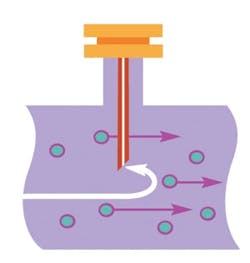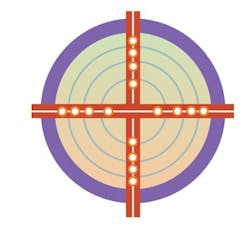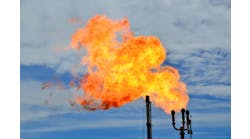Should You Use a Probe for Sampling?
Deciding whether to use a probe to extract process samples for your analytical system is relatively easy. For most applications, installing a probe makes sense. However, sometimes a probe isn’t needed; using one may present limited or no benefits — along with added costs.
To make an informed decision, you’ll need to know the exact condition of the process fluid at the process tap. What are the process temperature and pressure? What’s the physical makeup of the fluid — how much gas, liquid and solid does the stream contain? If it’s a gas, what’s the dew point temperature? If it’s a liquid, what’s the bubble point temperature? Also, try to determine the particle size distribution of any solids present.
Figure 1. Device extends into the process fluid and withdraws a continuous flow for analysis.
Although the full design of a probe will use all of these data, here we’ll simply review some advantages of probes. We’ll also discuss when a probe isn’t recommended.WHY USE A PROBE?In an analytical sampling system, a probe typically is inserted into a nozzle at the process tap location to extract samples for analysis (Figure 1). (For details about the location and orientation of nozzles, see the first article in this series — “Properly Position Sampling Nozzles.") The probe, which in its simplest form is a metal, glass or ceramic proboscis, extends into the process fluid. Sample fluid enters the proboscis, and the probe withdraws a continuous flow for analysis. Alternatively, a nozzle by itself, i.e., without a probe, can deliver samples to the analyzer (Figure 2). However, for most systems, probe sample delivery offers advantages compared to nozzle sample delivery, including inherent filtering, faster analyses and better samples.A probe filters the sample. A probe acts as a filter in an analytical instrumentation system, keeping dust, pipe scale and entrained liquid drops out of the extracted sample. It’s commonly believed that probes exclude 85% of particulates in a process stream. This efficiency can equate to significant savings in filter elements and labor costs. For example, a filter that plugs daily without a probe in use potentially could operate for a week or more without plugging if a probe is used. The exact savings depend upon the number and nature of particles in the process stream as well as the operating conditions but there’s no doubt the probe will help extend the life of the filter.The key to a probe’s filtering effect is particle momentum. Figure 3 illustrates how inertia keeps the particles in a process stream moving downstream rather than executing a sharp turn into the mouth of the probe. The separation is most effective when the particles are heavy or denser than the process fluid. That’s why probes will filter gas streams better than liquid streams.The direction and speed of particles also contribute to them not being sucked up into a probe.Figure 2. A nozzle with either a female threaded boss (top) or male threaded pipe nipple (bottom) by itself can deliver samples.
You might expect that low-velocity laminar flow, in which all stream molecules are moving parallel to one another and parallel to the pipe wall, would enable the best filtering. However, the low fluid velocity actually may allow more particles to enter the probe.In contrast, turbulent flow can enhance the filtering capabilities of a probe. In a turbulent flow, fluid is moving at a higher velocity; any slower molecules are bumped sideways into the faster flow and then accelerated to the higher speed. Although turbulence randomly kicks particles sideways across a pipe, their average downstream velocity in turbulent flow is higher than in laminar flow, minimizing their potential to be captured by the probe.One possible drawback with fast fluid flow is the risk of probe failure. You must ensure the probe can withstand the velocity of the stream so it doesn’t vibrate and eventually snap off.Even without the inherent momentum-based filter effect, probes can extract cleaner samples than nozzle-only systems. Solid debris tends to collect near pipe walls, where flow energy is low. In gas streams, any entrained liquids also will wet the walls and cling to them. If you don’t use a probe that extends sampling extraction away from pipe walls, these solids or liquids will flow into the nozzle and down the transport line, eventually blocking the filters and perhaps flooding the analyzer. The solution is easy: use a probe to sample from the cleaner fluid nearer the center of the line.A probe enables faster responses. A system using a probe delivers a quicker analysis response than a system relying solely on a nozzle to extract samples. The probe samples from the center of a process stream, where the velocity is highest. Sampling this faster-moving flow ensures more process fluid reaches the analyzer sooner, which results in a speedier analysis.In addition, a probe reduces the required purge time for sample analysis because the volume that must be purged is limited to that of the small bore of the probe. Without a probe, you must purge the entire nozzle volume. Plus, new and old molecules constantly are mixed together in the nozzle volume. So, to ensure the sample is representative of current process conditions, your purge must amount to at least three times the nozzle volume. Consider a typical 150-mm nozzle fabricated of 2-in. pipe: three times its volume is almost a liter. For a liquid fast-loop flow of 10 L/min, the purge delay in that nozzle is six seconds, which might be acceptable. However, suppose the process is a gas at 30 barg and the sample line has a vent flow of 1 L/min, the nozzle purge delay here is about 30 minutes.Figure 3. Inertia keeps the particles in a process stream moving downstream instead of flowing into the probe.
A probe provides representative samples. A probe can extract a more-representative sample than a nozzle connection because it’s pulling samples from the center of the process stream, not the edges where samples may not be fully mixed.However, this oft-touted benefit may not live up to its reputation. By its nature, a probe is selective — it will exclude some solids or liquids from your sample. Any omission can change the composition of the sample. Still, the selectivity of a probe is one of its chief values and a very good reason to use one.When analyzing gas from a large duct or stack, a multi-ported probe (Figure 4) may improve the representativeness of your samples. Such a probe has many ports positioned across the duct, allowing it to extract an average sample that represents the entire stream better than any single-port probe could.WHEN NOT TO USE A PROBEDespite offering many benefits, a probe isn’t always necessary. When a stream contains no solid particles or entrained liquids, the only advantage of a probe is a faster response. If you already have a large nozzle in place, the reduction in lag time by eliminating triple purging the mixing volume could justify adding a probe. However, if you’re adding a new tap to a small line, it may be easier to install a short ¾-in. pipe nozzle and run enough sample flow to purge it.Don’t use a probe on a very small pipeline because it can obstruct the process flow. Some project specifications discourage probes on pipelines with less than 80-mm (3-in.) nominal bore. Base your decision on the potential for solid or liquid entrainment and the practicality of putting in a probe.The installation of a probe and nozzle incurs cost to the processor. The capital cost of a probe is greater than that of a simple ¾-in. pipe nozzle, and the probe likely will require some ongoing maintenance. If your fluid is very clean and the line contains no pipe debris, you can save money by not using a probe, provided you can accept the slower analyzer response to process changes.However, omitting a probe from a line carrying a wet gas or dirty fluid represents a false economy. Any fluid with an expected solid content demands a probe, as does any gas carrying entrained liquid drops. Otherwise, the reliability of the analyzer will suffer.You should avoid a projecting probe if the pipeline is subject to pigging. A pig is a shuttle sent down a pipeline to clean it or to separate one conveyed product from another. The pig will damage your probe. For large gas pipelines, a mechanism that retracts the probe on command and automatically reinserts it after the pig passes by is available.Figure 4. Several ports positioned across a wide duct improve the representativeness of the sample versus one obtained with a single-port probe.
DEAN SLEJKO is product manager, analytical products, for Swagelok Company, Solon, Ohio. E-mail him at [email protected].






